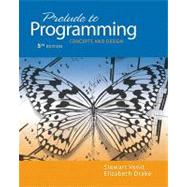Prelude to Programming provides beginning students with a language-independent framework for learning core programming concepts and effective design techniques. This approach gives students the foundation they need to understand the logic behind program design and to establish effective programming skills.
The Fifth Edition offers students a lively and accessible presentation as they learn core programming concepts – including data types, control structures, data files and arrays, and program design techniques such as top-down modular design and proper program documentation and style. Problem-solving skills are developed when students learn how to use basic programming tools and algorithms, which include data validation, defensive programming, calculating sums and averages, and searching and sorting lists. A copy of the RAPTOR flow-charting software is included with the Fifth Edition.








